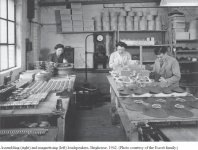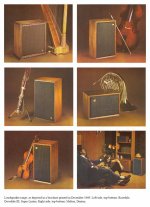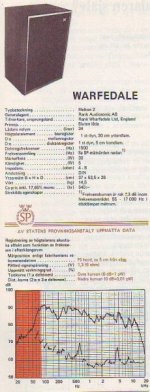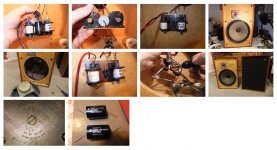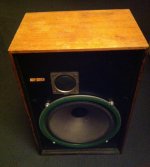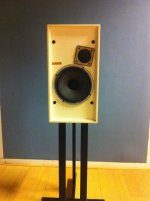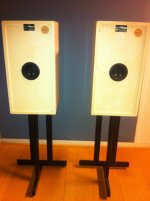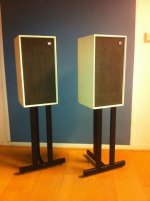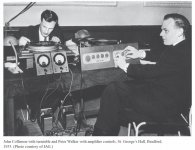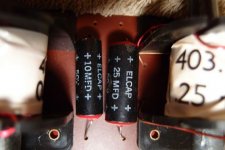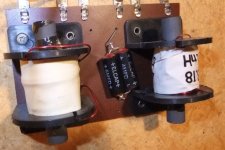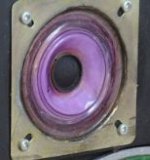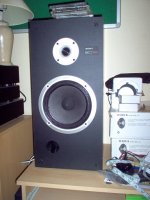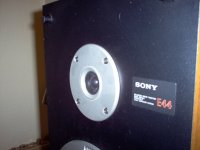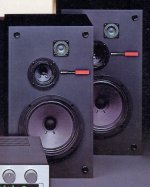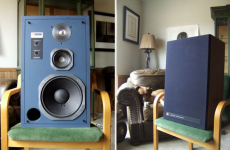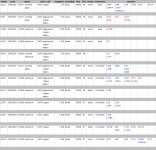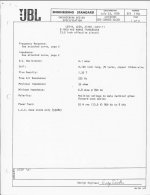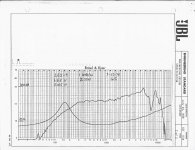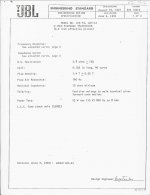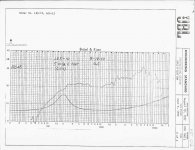I grew up in the late 1960s and 1970s listening to valve amps driving Goodmans 10" or 12" bass in a huge old box with 3" cone tweeter. I don't think crossovers were taken very seriously in those days. Usually just a 10uF capacitor to protect the tweeter from low frequencies. LOL.
It actually sounded tremendously realistic on occasion.
High frequencies around 15kHz weren't the main event with setups like this. It was mostly about the 300-3kHz midrange, which is what your ear is designed for.
I compared the Visaton modelling for a modern rubber surround, big magnet W200S in a tiny 12L with the very retro cloth surround B200 in 60L. They actually end up in much the same place.
Even on power handling, though you must trust me on this. Anyway, the comparison below. A lot to be said for the small box which works as well as the big one. Wharfedale did this sort of small box back in the seventies with the 20L Wharfedale Denton II with an 8" bass. Possibly the best selling speaker they ever made. FWIW, the cone midrange/tweeter was crossed quite low around 1.5kHz. It was a plastic unit with a built-in chamber around the size of a coffee-cup with some wadding. I quite like the old retro cloth-surround style though. The Sony E44 is so retro, it's laughable. But extremely musical IMO, especially with a good crossover.
I have had my experience with Wharfedale as well and will post some short comments later. Enclosed are 2 images from the Wharfedale archives.
Manufacturing loudspeaker drivers during WWII...
Sony produced some interesting Classic 2 and 3 Ways, especially the SEAS OEM coned versions. You have to rework the XO though, because Sony had the 20 cm cone of this E-44 play all the way up to 6000 Hz. In the 1980's this was common practice among many manufacturers, mainly in order to keep the tweeters operating within their safety zone.
Attachments
Last edited:
Years ago, I got a pair of Wharfedale Melton 2's and Linton 2's.
I Replaced the ancient caps (4 & 6 uf coupled bipolar caps) with a Mungdorf 10uf, as shown in the collage.
I did not measure the things, but the very thick rubber surround had stiffened over the years.
The tweeters of the Wharfedales from this era is a rather particuliar design. It's called a CAB cone which is an abbreviation of Cellulosic Butyrate Acetate.
I treated the surrounds with natural oil in order to weaken the rubber surrounds and hooked them up to a Chevin Research studio amp. While this was way beyond the power specs, it did open up the sound.
These rather big 2 ways had an overall pleasant sound with good imaging, especially with classic chamber, jazz and similar acoustic music.
Eventually, I fried a voicecoil while playing some electronic music. Apparently, the motor was no longer capable to adequately move the cone due to the extremely stiff(ened) suspension.
The Linton 2's had a similar sound quality, only 'scaled down'. All in all, these vintage Wharfedale loudspeakers are not bad, but obviously most modern drivers are much better compared to these Wharfedale units. Celestion, Kef and Goodmans in particular offered similar loudspeakers systems.
The last photos (bad early smartphone lenses) show 1 of my Melton 2's and a Linton 2. The Linton's still had their original white rubbing varnish coating, which was a rather expensive custom order finish.
Info from the vintageknob:
Wharfedale Linton 2 (1971-1974)
Shelf kind of bookshelf loudspeakers, siblings of the Denton 3.
Included in these acoustic suspensions were a long-throw spider 20cm bass "special" paper cone with rubber surround, an acoustically sealed 10cm mid/high driver with CAB cone (cellulosic Butyrate Acetate). The back proudly hid its modern molded plastic terminals.
The "2" in Linton 2, for once, isn't a series code but a two-way designation to separate it from its Linton 3 three-way sibling.
With 20L of internal volume, 9kg apiece and a maximum of 20W of input power, the Linton 2 and Linton 3 indeed were of the little shelf kind - comfortable in booksy mini shelf decor.
Next up were the big Melton 2, the tall Triton 3 and the Dovedale 3 variant of the Denton 3 - all rather successful.
Specs:
Type : acoustic suspension
Volume : 20L
Maximum input : 20W (DIN)
Nominal impedance : 6 Ohm
Drivers : 20cm bass, 1x 5cm mid/high
Frequency response : 55Hz...16Khz (± 3dB)
Crossover : 1,2Khz
Dimensions : 48,2H x 25,2W x 24D cm
Weight : 18,2kg / pair.
Finishes : teak with black grille cloth
walnut with brown grille cloth
Wharfedale Melton 2 (1971-1974)
Bigger shelf kind of bookshelf loudspeakers - where the shelf better be big otherwise it will slowly crumble. In fact the shelf better be the floor !
Included in the acoustic suspension design were a long-throw spider 30cm bass long-fiber paper cone with rubber surround, a 5cm mid/high friver with lightweight CAB cone (cellulosic Butyrate Acetate).
The enclosure is made of solid wood (front) with the top and sides veneered in teak or walnut.
Around the Melton 2 were the tall Triton 3 and the Dovedale 3 variant of the Denton 3 - all rather successful.
And, yes, there was a Melton 3, too.
These are a bit like the ALTEC model names : the first three you remember distinctly, the next ones blur a little - too many "ton" and too many "dale" sometimes
Specs:
Type : Acoustic suspension
Volume : 34L
Drivers : 1x 30cm, 1x 5cm mid/high
Nominal impedance : 6 Ohm
Power handling : 30W (DIN)
Frequency response : 45Hz...17Khz (± 3dB)
Crossover : 1,5Khz
Dimensions : 53,5 x 37 x 26cm
Weight : 14,5kg.
Finishes : teak with black grille cloth
walnut with brown grille cloth
I Replaced the ancient caps (4 & 6 uf coupled bipolar caps) with a Mungdorf 10uf, as shown in the collage.
I did not measure the things, but the very thick rubber surround had stiffened over the years.
The tweeters of the Wharfedales from this era is a rather particuliar design. It's called a CAB cone which is an abbreviation of Cellulosic Butyrate Acetate.
I treated the surrounds with natural oil in order to weaken the rubber surrounds and hooked them up to a Chevin Research studio amp. While this was way beyond the power specs, it did open up the sound.
These rather big 2 ways had an overall pleasant sound with good imaging, especially with classic chamber, jazz and similar acoustic music.
Eventually, I fried a voicecoil while playing some electronic music. Apparently, the motor was no longer capable to adequately move the cone due to the extremely stiff(ened) suspension.
The Linton 2's had a similar sound quality, only 'scaled down'. All in all, these vintage Wharfedale loudspeakers are not bad, but obviously most modern drivers are much better compared to these Wharfedale units. Celestion, Kef and Goodmans in particular offered similar loudspeakers systems.
The last photos (bad early smartphone lenses) show 1 of my Melton 2's and a Linton 2. The Linton's still had their original white rubbing varnish coating, which was a rather expensive custom order finish.
Info from the vintageknob:
Wharfedale Linton 2 (1971-1974)
Shelf kind of bookshelf loudspeakers, siblings of the Denton 3.
Included in these acoustic suspensions were a long-throw spider 20cm bass "special" paper cone with rubber surround, an acoustically sealed 10cm mid/high driver with CAB cone (cellulosic Butyrate Acetate). The back proudly hid its modern molded plastic terminals.
The "2" in Linton 2, for once, isn't a series code but a two-way designation to separate it from its Linton 3 three-way sibling.
With 20L of internal volume, 9kg apiece and a maximum of 20W of input power, the Linton 2 and Linton 3 indeed were of the little shelf kind - comfortable in booksy mini shelf decor.
Next up were the big Melton 2, the tall Triton 3 and the Dovedale 3 variant of the Denton 3 - all rather successful.
Specs:
Type : acoustic suspension
Volume : 20L
Maximum input : 20W (DIN)
Nominal impedance : 6 Ohm
Drivers : 20cm bass, 1x 5cm mid/high
Frequency response : 55Hz...16Khz (± 3dB)
Crossover : 1,2Khz
Dimensions : 48,2H x 25,2W x 24D cm
Weight : 18,2kg / pair.
Finishes : teak with black grille cloth
walnut with brown grille cloth
Wharfedale Melton 2 (1971-1974)
Bigger shelf kind of bookshelf loudspeakers - where the shelf better be big otherwise it will slowly crumble. In fact the shelf better be the floor !
Included in the acoustic suspension design were a long-throw spider 30cm bass long-fiber paper cone with rubber surround, a 5cm mid/high friver with lightweight CAB cone (cellulosic Butyrate Acetate).
The enclosure is made of solid wood (front) with the top and sides veneered in teak or walnut.
Around the Melton 2 were the tall Triton 3 and the Dovedale 3 variant of the Denton 3 - all rather successful.
And, yes, there was a Melton 3, too.
These are a bit like the ALTEC model names : the first three you remember distinctly, the next ones blur a little - too many "ton" and too many "dale" sometimes
Specs:
Type : Acoustic suspension
Volume : 34L
Drivers : 1x 30cm, 1x 5cm mid/high
Nominal impedance : 6 Ohm
Power handling : 30W (DIN)
Frequency response : 45Hz...17Khz (± 3dB)
Crossover : 1,5Khz
Dimensions : 53,5 x 37 x 26cm
Weight : 14,5kg.
Finishes : teak with black grille cloth
walnut with brown grille cloth
Attachments
Last edited:
@ Ro808
A friend of mine had the Wharfedale Linton's back in the day. We & lots of our friends spent many hours over the years, listening to Plenty of Great music on them. Thanx 4 the memories
RE - Wharfdale factory pic in Post #402
1942 was during WW2, so a lot of war news etc must have been listened to on Valve radios with them in. That factory room looks like so many images from back then. No wall insulation or double glazing etc etc. Hot in summer & cold & drafty in winter. At least conditions have vastly improved since then. But, i bet they were happy, & had more fun working than many in recent times.
A friend of mine had the Wharfedale Linton's back in the day. We & lots of our friends spent many hours over the years, listening to Plenty of Great music on them. Thanx 4 the memories
RE - Wharfdale factory pic in Post #402
1942 was during WW2, so a lot of war news etc must have been listened to on Valve radios with them in. That factory room looks like so many images from back then. No wall insulation or double glazing etc etc. Hot in summer & cold & drafty in winter. At least conditions have vastly improved since then. But, i bet they were happy, & had more fun working than many in recent times.
You are most welcome!
A few more images from Memory Lane then, with tubes.
I forgot to mention one remarkable aspect of these Wharfedales: the blend between the mid/high CAB cone and the woofers was quite exceptional. The low XO point obviously paid off.
A few more images from Memory Lane then, with tubes.
I forgot to mention one remarkable aspect of these Wharfedales: the blend between the mid/high CAB cone and the woofers was quite exceptional. The low XO point obviously paid off.
Attachments
We seem to have shared the Wharfedale experience, Ro808. I had the Lintons and the Meltons. The Melton was possibly more effortless and went deeper.
The tweeter was really a 3" midrange in a small coffee-cup sized plastic enclosure filled with wadding.
Seems like Wharfedale gave it 10uF and 0,18mH. Bass filter to suit around 1kHz.
I have the Sony E44, but it doesn't look like an old SEAS unit to me. But very musical. The tweeter is good too. The original woeful crossover was just 3.3uF to the tweeter. I tidied it all up considerably. Very nice.
The tweeter was really a 3" midrange in a small coffee-cup sized plastic enclosure filled with wadding.
Seems like Wharfedale gave it 10uF and 0,18mH. Bass filter to suit around 1kHz.
I have the Sony E44, but it doesn't look like an old SEAS unit to me. But very musical. The tweeter is good too. The original woeful crossover was just 3.3uF to the tweeter. I tidied it all up considerably. Very nice.
Attachments
Member
Joined 2009
Paid Member
That's fortuitous, Steve.
The Weltons did deliver a clean, firm low end. I had to push it tough, because of the stiff surrounds. Nevertheless, they managed to rattle 'things'.
The appartment in which I lived at that time, allowed me to make a lot of noise, which I did on a regular basis.
The Weltons easily would go north from 100dB. But, I have to admit, the voicecoil eventually melted -at least partly- because of this torture.
The woofer of the Sony E-44 is not from SEAS. It appears to be a light cone with a finely structured, coated fabric surround. Similar to a pro mid/low woofer.
Tomorrow I'll post some SEAS Sony stuff.
The Weltons did deliver a clean, firm low end. I had to push it tough, because of the stiff surrounds. Nevertheless, they managed to rattle 'things'.
The appartment in which I lived at that time, allowed me to make a lot of noise, which I did on a regular basis.
The Weltons easily would go north from 100dB. But, I have to admit, the voicecoil eventually melted -at least partly- because of this torture.
The woofer of the Sony E-44 is not from SEAS. It appears to be a light cone with a finely structured, coated fabric surround. Similar to a pro mid/low woofer.
Tomorrow I'll post some SEAS Sony stuff.
Last edited:
This is one example:
Sony SS-2030
Specs:
3-way configuration,
closed box,
paper cone woofer Seas 21F-GWS 200mm, textile surround, diecast basket,
paper cone midrange Seas 10F-LG 100mm, textile surround, diecast basket, acoustic chamber,
paper cone tweeter Seas 5TV-HFS 50mm, AlNiCo magnet,
30W@8Ω,
45-18000Hz,
sens. -- dB,
mm 280x500x229, kg 7,0.
All drivers and crossover are exposed here
Sony SS-2030
Specs:
3-way configuration,
closed box,
paper cone woofer Seas 21F-GWS 200mm, textile surround, diecast basket,
paper cone midrange Seas 10F-LG 100mm, textile surround, diecast basket, acoustic chamber,
paper cone tweeter Seas 5TV-HFS 50mm, AlNiCo magnet,
30W@8Ω,
45-18000Hz,
sens. -- dB,
mm 280x500x229, kg 7,0.
All drivers and crossover are exposed here
Attachments
Last edited:
Two JBL 4313B monitors are singing again!
On another side note here are my two JBL 4313B monitors that I completely reconditioned by replacing the woofer surrounds, replaced the LE5-9 midrange, changed out the old crossover caps w/ Solens and repaired, cleaned and reattached the grill cloth. The process, links and crossover schematics can be found here:
Two 4313B's are singing again...
They sound wonderful.
On another side note here are my two JBL 4313B monitors that I completely reconditioned by replacing the woofer surrounds, replaced the LE5-9 midrange, changed out the old crossover caps w/ Solens and repaired, cleaned and reattached the grill cloth. The process, links and crossover schematics can be found here:
Two 4313B's are singing again...
They sound wonderful.
Attachments
That looks like a stunning job!
I've always been intrigued by that rare dome.
Tolerances in vintage JBL drivers are amazing, even by today's standards.
The LE-5/8 is a classic, but it's a difficult driver according to Troels.
Crossovers in vintage JBL monitors should be reworked and upgraded.
European HES LE-5/8 alternatives:
The FANE vintage 5m
RCF's classic 5".
I've always been intrigued by that rare dome.
Tolerances in vintage JBL drivers are amazing, even by today's standards.
The LE-5/8 is a classic, but it's a difficult driver according to Troels.
Crossovers in vintage JBL monitors should be reworked and upgraded.
European HES LE-5/8 alternatives:
The FANE vintage 5m
RCF's classic 5".
Last edited:
Some interesting notes and official JBL documents on the different LE5 versions from legendary JBL engineer Greg Timbers.
(Source: audioheritage).
The Alnico LE5-2 and LE5-3
For reasons not very well understood, there are two versions of the LE5-2, the round wire version and the ribbon wire version. Just knowing the model number doesn't help. Later versions of the LE5-2 were round wire only and the LE5-3 became the ribbon wire version. The Alnico motors had a .080 gap height and a flux density of 1.65 T.
The Ferrites
The ferrite motors had a .140 gap height and a flux density of 1.35 T.
General
All the LE5's used the same cone and spider. Dust domes were either paper or aluminum. The voice coils were either ribbon or round and all of them had a .125 voice coil height. The odd model numbers used the ribbon voice coil, were more efficient and had a more level curve good to ~ 8 to 10 kHz. The even model numbers used the round voice coil, had more of a rising response and were good to ~ 16 kHz.
(Source: audioheritage).
The Alnico LE5-2 and LE5-3
For reasons not very well understood, there are two versions of the LE5-2, the round wire version and the ribbon wire version. Just knowing the model number doesn't help. Later versions of the LE5-2 were round wire only and the LE5-3 became the ribbon wire version. The Alnico motors had a .080 gap height and a flux density of 1.65 T.
The Ferrites
The ferrite motors had a .140 gap height and a flux density of 1.35 T.
General
All the LE5's used the same cone and spider. Dust domes were either paper or aluminum. The voice coils were either ribbon or round and all of them had a .125 voice coil height. The odd model numbers used the ribbon voice coil, were more efficient and had a more level curve good to ~ 8 to 10 kHz. The even model numbers used the round voice coil, had more of a rising response and were good to ~ 16 kHz.
Attachments
That looks like a stunning job!
I've always been intrigued by that rare dome.
Tolerances in vintage JBL drivers are amazing, even by today's standards.
The LE-5/8 is a classic, but it's a difficult driver according to Troels.
Crossovers in vintage JBL monitors should be reworked and upgraded.
European HES LE-5/8 alternatives:
The FANE vintage 5m
RCF's classic 5".
Here is an article that I employed with the croosover replacement with an additional .01uF bypass that you may find interesting. Bypassed and Biased Capacitors
I was aware of the practice from regular JBL literature, but these examples are educational.
Bypassing makes sense, especially when high value caps are involved and is useful in 'voicing' a crossover. The latter is common practice at Living Voice, Audio Note and many other small manufacturers.
It seems an immensely repetitive job in order to find tiny (subjective) improvements in sound quality.
I do believe in the added value of a quality cap, figuratively speaking. But from an electrical point of view and as a proponent of straightforward engineering, I don't see any merit in going overboard with exotic beewax bull....
Paper in oil, tin foil.... It depends.
Bypassing makes sense, especially when high value caps are involved and is useful in 'voicing' a crossover. The latter is common practice at Living Voice, Audio Note and many other small manufacturers.
It seems an immensely repetitive job in order to find tiny (subjective) improvements in sound quality.
I do believe in the added value of a quality cap, figuratively speaking. But from an electrical point of view and as a proponent of straightforward engineering, I don't see any merit in going overboard with exotic beewax bull....
Paper in oil, tin foil.... It depends.
Last edited:
can't help thinking we haven't come that much further in speaker design over time
This post crossed my mind while hunting for the origin of the woofer in Steve's Sony E-44's. I have found it and will dedicate a seperate post tomorrow.
HARMAN/Samsung is illustrative of what has been going on for decades in the loudspeaker industry.
Due to changes in the markets, demand and supply side: consumer preferences, increased competition, cost reduction etc. the focus of manufactures has changed as well. Not necessarily for the better.
These days, a streamlined business model is essential in order to survive.
I won't start a philosophical/political debate here, but a consequence of this shift is: there is more of the same.
Which is a pity, but at least by diy we are able to build 'out of the ordinary things'.
As a result of a shift towards specialization great parts - i.e. loudspeaker components - are (still) available.
Except from JBL in the near future.
Last edited:
Member
Joined 2009
Paid Member
Sometimes I DIY something just to be different. But it doesn't always satisfy once finished. This thread is about classic designs - which for me implies time-proven designs that do satisfy - is there a place in the DIY realm for a classic monitor build using new available materials and drivers - AND yet achieve modern performance ?
OK, let's assume there are some modern drivers that are actually pretty darn good (feel free to pick your fav)
It seems we have learned that the big box with flat baffle and diffraction-prone edges aren't what we want. For me, I like the classic look, but do I sacrifice performance to retain these looks ?
OK, let's assume there are some modern drivers that are actually pretty darn good (feel free to pick your fav)
It seems we have learned that the big box with flat baffle and diffraction-prone edges aren't what we want. For me, I like the classic look, but do I sacrifice performance to retain these looks ?
Choose your poi... , I mean trade off.
I guess, you would be best served by one of Troels' Classic 3 Ways.
An upscaled 3 way would be nice:
10" low, 4-5,5" mid + tweet.
With 3.75 (or bigger) roundovers on the baffle, diffraction won't be an issue.
Check Steve's tip on woofer impedance vs. BSC, a few pages back.
I guess, you would be best served by one of Troels' Classic 3 Ways.
An upscaled 3 way would be nice:
10" low, 4-5,5" mid + tweet.
With 3.75 (or bigger) roundovers on the baffle, diffraction won't be an issue.
Check Steve's tip on woofer impedance vs. BSC, a few pages back.
Last edited:
The late Irving “Bud” Fried (1920–2005) blazed a trail through high-end audio’s formative years, first as an importer of classic British gear and later, starting in the 1970s, as a manufacturer of transmission line (TL) speakers under the Fried name. His strongly held beliefs about loudspeaker design were based, as he put it, upon the inexorable laws of physics, and he wasn’t afraid to promote and defend his ideas within the audiophile community. Fried maintained that the ideal loudspeaker would preserve the audio signal’s time coherency, which explains his fondness for the non-resonant bass response of TL designs. However, his pet preference for series, rather than parallel crossover networks, seems a bit quaint today after 40 years of progress in this field.
At the suggestion of Saul Marantz, the IMF (Irving M Fried) trademark was registered in 1961, a trademark that was eventually applied to many advanced developments in music reproduction: cartridges (IMF - London, IMF - Goldring), tone arms (SME, Gould, Audio and Design), amplifiers (Quad, Custom Series), loudspeakers (Lowther, Quad, Celestion, Bowers and Wilkins, Barker, etc.) In 1968 a British branch of IMF was opened. This combined Anglo-American company produced the now legendary IMF Monitor, the first truly wide band loudspeaker the world had seen. In 1975 the English and American divisions of IMF were split, and the trademark FRIED was thenceforth used on all of Bud's designs. The new designs were based upon the same inexorable laws of acoustics that had created the IMF Monitor in addition to new technology as it became available. FRIED benchmarks include the Model H System, the first modern satellite/subwoofer system, the Model M (1977), the first satellite transmission line subwoofer in one unit, the SUPER Monitor (which many still consider to be one of the premier speakers of our day), and the B satellite series (1976 to 1979).
TDL continued the IMF legacy with improved TL designs.
Quote from diyaudio member dnsey:
"I ran a pair of TLS50s for a couple of years.
The bass was truly impressive - tighter than most reviewers would have you believe, and extended right down to 'feel' frequencies. Acoustic bass was particularly startling in its realism.
However, the imaging seemed almost non-existant (four drivers), and the midrange was distinctly woolly. Changing the crossover caps for decent polys helped a bit.
These days, I'd happily have another pair, but mod them into 3-way units with decent MF drivers."
You will find a ton of info on IMF and TDL, including suggestions for modifications here
(the website of diyaudio member planet10), here
and here
From a Scandinavian forum:
"Not to offend anyone, the IMF are excellent vintage speakers, but they have their limitations, especially in the blend between the drivers. KEF B139 is a device with constraints. B110, this was used in many high-end speakers with different coating on the diaphragm to try to dampen the large breakup. This is also a vintage driver, with restrictions.
Later versions of IMF and TDL were much improved with better filters, better drivers, better cabinets, and the speakers from IMF or TDL are still highly rated by many."
While the IMF's are interesting loudspeakers, I think these are also quite complicated and this potpourri of drivers....
The smaller ones appear more straightforward/basic designs.
I found loads of these old kef drivers in storage, many of them with burned voice coils. Recently, I worked with a dsp controlled omni directional system which is based on OEM polyprop KEF units. They did the omni trick, but I could not appreciate the plastic sound.
I have owned some (expensive) PMC monitors, which are TL (sort of) loudspeakers. These literally do sound slow in the low frequencies, with 'overhang' in the low and mid bass that seems to lag behind the rest.
The only TL loudspeakers I would consider to build are Lynn Olson's Orions.
At the suggestion of Saul Marantz, the IMF (Irving M Fried) trademark was registered in 1961, a trademark that was eventually applied to many advanced developments in music reproduction: cartridges (IMF - London, IMF - Goldring), tone arms (SME, Gould, Audio and Design), amplifiers (Quad, Custom Series), loudspeakers (Lowther, Quad, Celestion, Bowers and Wilkins, Barker, etc.) In 1968 a British branch of IMF was opened. This combined Anglo-American company produced the now legendary IMF Monitor, the first truly wide band loudspeaker the world had seen. In 1975 the English and American divisions of IMF were split, and the trademark FRIED was thenceforth used on all of Bud's designs. The new designs were based upon the same inexorable laws of acoustics that had created the IMF Monitor in addition to new technology as it became available. FRIED benchmarks include the Model H System, the first modern satellite/subwoofer system, the Model M (1977), the first satellite transmission line subwoofer in one unit, the SUPER Monitor (which many still consider to be one of the premier speakers of our day), and the B satellite series (1976 to 1979).
TDL continued the IMF legacy with improved TL designs.
Quote from diyaudio member dnsey:
"I ran a pair of TLS50s for a couple of years.
The bass was truly impressive - tighter than most reviewers would have you believe, and extended right down to 'feel' frequencies. Acoustic bass was particularly startling in its realism.
However, the imaging seemed almost non-existant (four drivers), and the midrange was distinctly woolly. Changing the crossover caps for decent polys helped a bit.
These days, I'd happily have another pair, but mod them into 3-way units with decent MF drivers."
You will find a ton of info on IMF and TDL, including suggestions for modifications here
(the website of diyaudio member planet10), here
and here
From a Scandinavian forum:
"Not to offend anyone, the IMF are excellent vintage speakers, but they have their limitations, especially in the blend between the drivers. KEF B139 is a device with constraints. B110, this was used in many high-end speakers with different coating on the diaphragm to try to dampen the large breakup. This is also a vintage driver, with restrictions.
Later versions of IMF and TDL were much improved with better filters, better drivers, better cabinets, and the speakers from IMF or TDL are still highly rated by many."
While the IMF's are interesting loudspeakers, I think these are also quite complicated and this potpourri of drivers....
The smaller ones appear more straightforward/basic designs.
I found loads of these old kef drivers in storage, many of them with burned voice coils. Recently, I worked with a dsp controlled omni directional system which is based on OEM polyprop KEF units. They did the omni trick, but I could not appreciate the plastic sound.
I have owned some (expensive) PMC monitors, which are TL (sort of) loudspeakers. These literally do sound slow in the low frequencies, with 'overhang' in the low and mid bass that seems to lag behind the rest.
The only TL loudspeakers I would consider to build are Lynn Olson's Orions.
Attachments
-
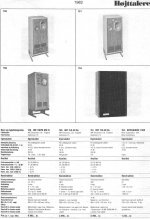 IMF_1982.jpg225.9 KB · Views: 91
IMF_1982.jpg225.9 KB · Views: 91 -
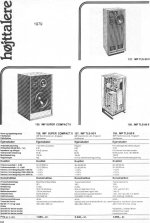 IMF_1979.jpg206.6 KB · Views: 106
IMF_1979.jpg206.6 KB · Views: 106 -
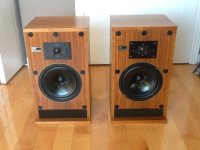 IMF Compact Monitor 2_1.jpg57.6 KB · Views: 122
IMF Compact Monitor 2_1.jpg57.6 KB · Views: 122 -
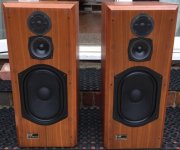 IMF HPCM_1_Edited.jpg73.1 KB · Views: 104
IMF HPCM_1_Edited.jpg73.1 KB · Views: 104 -
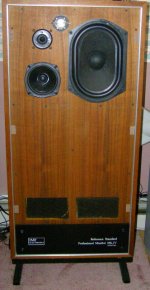 IMF_RSPM_MkIV_1.jpg192.4 KB · Views: 95
IMF_RSPM_MkIV_1.jpg192.4 KB · Views: 95 -
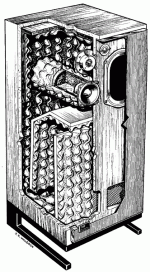 cutawayTLS80.gif68.5 KB · Views: 100
cutawayTLS80.gif68.5 KB · Views: 100 -
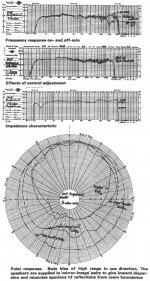 graphspromonreview.jpg240.2 KB · Views: 81
graphspromonreview.jpg240.2 KB · Views: 81 -
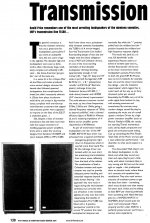 hi-fi world tls80.jpg465.4 KB · Views: 114
hi-fi world tls80.jpg465.4 KB · Views: 114 -
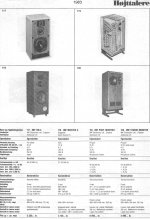 IMF_1983.jpg228.5 KB · Views: 84
IMF_1983.jpg228.5 KB · Views: 84
Last edited:
- Home
- Loudspeakers
- Multi-Way
- Classic monitor designs?
